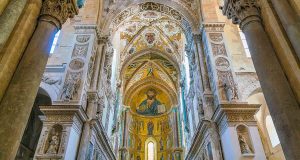The Temple of Diana in Cefalù is one of the monuments that can be seen when visiting the Rocca that dominates the town. Despite the name, in reality there is still an aura of mystery around this construction. In fact, it is not clear whether it was a temple, a royal palace or a defensive fortress. In the late 18th century, the Frenchman Jean-Pierre Houël immortalized this monument in some of his famous watercolors. Then as now, the Temple of Diana fascinates travelers from all over the world.
The Temple of Diana in Cefalù
The term “Temple of Diana” of Cefalù generally refers to the remains of a building located in the rock of Cefalù. Despite its name, there is no certainty that it was actually a temple or that it was named after the goddess of the hunt. What is certain is that the construction of the building took place in several phases. The oldest part is the cistern, which would date back to the 9th century B.C. It was dug directly into the rock and is surrounded by large stone slabs resting on the edges and on an architrave supported by a central column of cylindrical blocks. The façade, on the other hand, dates from the fifth century B.C. and is made of large irregularly shaped stone blocks. The upper part, which includes the lintel and the jambs, seems to date from the 2nd century B.C. and differs from the rest in its use of well-squared stones.
The function of the temple
The function of the so-called Temple of Diana of Cefalù is still shrouded in mystery. In fact, scholars have not yet been able to establish with certainty what this structure was used for and have proposed different solutions. Its location, far from the town, would suggest a use other than a place of worship. According to some, it could have been the seat of the royal palace of the first kings of Kephaloidion, the ancient Greek city. Instead, the presence of the water cistern has led some scholars to believe that it was a fortified sanctuary dedicated to the worship of water-related pagan deities. The presence of the remains of two different churches, one inside the temple and the other above, leaves no doubt that the area was also used for religious purposes.
Visiting the Temple of Diana of Cefalù: how to get there, times and prices
The Temple of Diana of Cefalù is one of the most important attractions you can visit in the Rock, along with the ruins of the Castle. The monument is located about 500 meters from the start of the route and can be reached in about 15 minutes on foot. The climb to the top of the Rocca is almost always sunny. It is therefore recommended to avoid the summer months and in any case the hottest times of the day. The entrance to the Rocca di Cefalù is in Salita Saraceni street and the ticket costs 5 euros. However, there are discounts for children from 6 to 14 years, the over 65s and teachers, the cost is 2.50 euros. The route is open every day of the year. From April to October, visits are allowed from 8 a.m. to 8 p.m. with last access at 7 p.m. From November to March, visits are allowed from 9 a.m. to 4 p.m. with last access at 3 p.m.
Aggiungi ai preferiti



















